From the Lampert Library
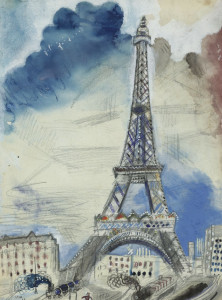 On my recent trip to France, I was lucky to see not one, but two, exhibits of Marc Chagall’s work. Having just read The Bridal Chair, a fictionalized look at Chagall’s life through his daughter’s eyes, the exhibits were particularly relevant.
On my recent trip to France, I was lucky to see not one, but two, exhibits of Marc Chagall’s work. Having just read The Bridal Chair, a fictionalized look at Chagall’s life through his daughter’s eyes, the exhibits were particularly relevant.
Northern France, where my daughter and her family live, has been likened to our Appalachia. The mining, textile and related industry have almost disappeared, leaving an economic void that is being replaced with mail order firms, light industry, printing, food processing and tourism.
Politically, the area has been solidly Socialist for the past forty years until the last election in December. The staunch Socialists were on tenterhooks when the election results showed LePen’s party of the right as the largest vote getter. However, the old roots came to the surface in the final round when the region again went Socialist.
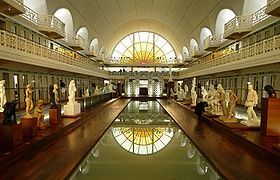 However, this Nord-Pas de Calais region of France is hardly a wasteland: almost every town has a first class museum and beautiful public buildings; history is deeply imbedded in the life of the region. Many World War I battles were fought nearby and the underground was strong during WWII as the centers of many of the cities and towns were bombed and destroyed.
However, this Nord-Pas de Calais region of France is hardly a wasteland: almost every town has a first class museum and beautiful public buildings; history is deeply imbedded in the life of the region. Many World War I battles were fought nearby and the underground was strong during WWII as the centers of many of the cities and towns were bombed and destroyed.
With the arrival of the Chunnel, the area is reinventing itself with public projects, tourism, improving the basic services, adding green space, growing the universities, and repurposing little used buildings. The area is the mail order center of France.
To get back to the Chagall exhibit…the large of the two exhibits was mounted at La Piscine, a beautiful art deco former municipal swimming pool that was built for the factory workers of the town of Roubaix and completed in 1932. When the pool closed in 1985, the structure was remodeled and, with a bow to the area’s former glory as a textile center, reopened as a museum of art and industry in 2000. A modern entrance and exhibit space was added, as well as a lovely little café and a gift shop. Even the changing booths are used as mini galleries.
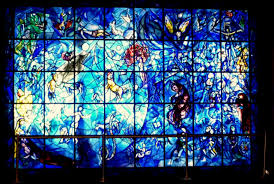 The Chagall exhibit features paintings, sculpture, life size photos of mosaics, textiles and stained glass. Most of us are familiar with Chagall’s floating fiddler and flying cows, but aren’t aware of the origins. Having just read the well-researched novel by Gloria Goldreich, the bits and pieces in each painting, even the choice of colors became more understandable. One must, however, separate Chagall the painter from Chagall the person.
The Chagall exhibit features paintings, sculpture, life size photos of mosaics, textiles and stained glass. Most of us are familiar with Chagall’s floating fiddler and flying cows, but aren’t aware of the origins. Having just read the well-researched novel by Gloria Goldreich, the bits and pieces in each painting, even the choice of colors became more understandable. One must, however, separate Chagall the painter from Chagall the person.
Chagall wasn’t a very nice man: vain, selfish, egotistical, and sometimes cruel. But he was also emotionally scarred from his experience in Russia and always 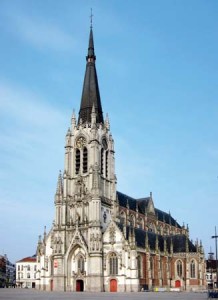 perceive himself to be an exile. He yearned for the Russia of his childhood. His creativity took those early years and that yearning and transformed them.
perceive himself to be an exile. He yearned for the Russia of his childhood. His creativity took those early years and that yearning and transformed them.
The second exhibit was like the icing on the proverbial cake. We had planned our visit to La Piscine, but the second exhibit in the city of Tourcoing was unexpected. I had planned to accompany Rebecca to the municipal library in this former textile city where she was teaching an English conversation class. The library was a striking new facility built in an underserved part of the city and meant to attract new people to the library.
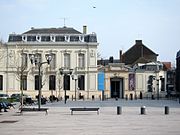 The MUBA (Musée des Beaux-Arts), the municipal museum, on the occasion of the 30th anniversary of Chagall’s death was showing Chagall’s woven work for the first time. Situated across the street from the massive municipal building, the Museum is housed in a former 19th century mansion.
The MUBA (Musée des Beaux-Arts), the municipal museum, on the occasion of the 30th anniversary of Chagall’s death was showing Chagall’s woven work for the first time. Situated across the street from the massive municipal building, the Museum is housed in a former 19th century mansion.
There bright, open galleries showcased the huge tapestries, another example of Chagall’s genius and versaltily. For some of the tapestries, Chagall actually collaborated with master weaver Yvette Cauquil-Prince and with Gobelins, the legendary manufacturer of tapestries since the 15th century.
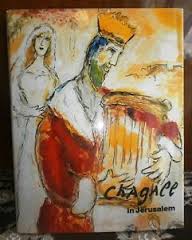 Working from Chagall’s sketches or even original paintings, the weaver created a cartoon as a guide to the weaving. Some of these tapestries were specially commissioned such as the ones for the Israeli Knesset and the Musée Marc Chagall in Nice.
Working from Chagall’s sketches or even original paintings, the weaver created a cartoon as a guide to the weaving. Some of these tapestries were specially commissioned such as the ones for the Israeli Knesset and the Musée Marc Chagall in Nice.
It was fascinating to see the works on paper and canvas, translated into a woven piece often much larger than the original inspiration. In addition, the exhibit explained the process of transforming the paintings into tapestry and one was able to see the backs of some pieces.
Airfares are low right now. Because of their popularity, the exhibits have been extended into February. A trip to northern France can be an adventure in discovering a beautiful, gritty, surprisingly rich area of the country which most Americans never see. There’s more to France than Paris and Provence. There is a vibrant bilingual presence because of the proximity to England; the train from Lille to St. Pancras Station, London takes as little as 82 minutes. So pop on over and visit my daughter while you’re there for a touch of New Jersey in Northern France. And enjoy some of the best beer in the world!
For further information about Chagall and his work consult the following available in the library:
Chagall is a coffee table book of large reproductions of the artist’s work
Chagall, Burning Lights: a unique double portrait of the warm world of Russian Jewry is a text by Bella Chagall and thirty-six drawings by Marc Chagall
Freund, Jewels for a Crown: the story of the Chagall windows
For young readers:
Landmann, I am Marc Chagall is an inventive biography of the artist using collage illustrations incorporating Chagall’s themes and works.
Leymarie, The Jerusalem Windows is filled with sketches and photos of the finished windows.
Loumaye, Chagall: my sad and joyous village features reproductions set into the story of a young boy inspired by Chagall’s work. For young readers.
Markel, Dreamer form the Village: the story of Marc Chagall, a picture book biography of the artist, uses his palette in the illustrations. For young readers.
Raboff, Marc Chagall is beautifully illustrated with full color reproductions and the artist’s black and white sketches. For young readers.
Venezia, Marc Chagall is a light hearted biography of the artist with Venezia’s signature cartoons. A good initial introduction for young readers.
REMEMBER, BOOKS LABELED FOR YOUNG READERS ARE NOT JUST FOR THE YOUNG.
- Is It Passover Yet? - Thu, Apr 18, 2024
- MESH Report April 9, 2024 - Thu, Apr 11, 2024
- Guess Who? - Wed, Mar 13, 2024
